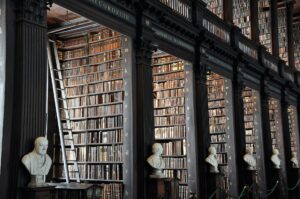Introduction to Romanticism
Romanticism is a period in the literature that holds significance for many. It was an artistic, intellectual and literary movement that began during the late 18th century and lasted until the middle of the 19th century. This period saw significant changes in thought processes, values, beliefs and ideals. It can also be defined as exploring the power of emotion to shape our understanding of art, how we view ourselves, and our relationship with those around us.
The romantic movement hugely influenced poetry because it gave rise to a new style of writing that focused heavily on emotion and imagination. Poets such as Wordsworth, Coleridge and Byron used vivid imagery and evocative language to express their ideas about love, nature and life’s struggles. These poets wrote from their own experiences and personal feelings – this heightened sense of self-awareness helped them create powerful works that resonated with readers across time.
To understand why it has been so influential over the centuries, one must look at some key elements within its philosophy: passion, creativity, freedom and transcendence are all core components that make up this unique expression. By allowing themselves to access deep emotions through words alone, these writers could craft stories filled with beauty that explored the depths of human experience in ways never seen before. Ultimately, they achieved something lasting – creating work that still inspires people today.
The Relationship Between Nature And The Human Experience In Romanticism Poetry
Romanticism in poetry is characterized by its focus on beauty and the natural world. This period of literature was highly influenced by the works of poets such as Lord Byron who used nature to describe human emotions, experiences, and relationships. By exploring this connection between nature and the human experience within romanticist poetry, we can better understand how these writers saw their work and its meaning in society.
The importance of nature to many romantic poets cannot be understated; it serves as an emotional outlet for them that allows readers to relate to the poem’s message more deeply. In Lord Byron’s “Childe Harold’s Pilgrimage,” he uses sweeping landscapes and vivid imagery to express his feelings about life. He talks about the grandeur of Nature while simultaneously connecting it with his inner struggles.
Other Romantic Poets like William Wordsworth use Nature as a metaphor for internal strife or transition, transforming mundane details into something meaningful and beautiful.
Considering these examples from well-known writers, one can appreciate how they use nature to convey deeper messages about the human experience. Their use of descriptive language helps bring out parts of themselves that may have otherwise been hidden or overlooked without using Nature as a tool for expression. Through this technique, readers can connect with themes relating to love, loss, longing, mortality, etc., all through nature’s lens. It has so much to offer in terms of its ability to capture emotionality alongside descriptions of natural scenery – making it an enduring influence in literary history today.
Characteristics Of Romanticism
It is a movement that began in the late 1800s and peaked during the early 1900s. It was characterized by its focus on human emotion, nature, and imagination. Mary Shelley’s Frankenstein is often seen as one of the best examples of romantic literature. Its characteristic can generally be broken down into three main categories:
- an emphasis on strong emotion and feeling rather than reason.
- a deep appreciation for the power of nature.
- and an idealization of creative expression through art, music, or poetry.
One key characteristic of Romanticism is its emphasis on powerful emotions such as love, sorrow, anger, joy etc., over logic and reason. This style also explores how these feelings are connected to events in everyday life such as death and war. Romantic poets were drawn to themes like death, suffering, unrequited love and epic journeys across vast landscapes which they believed had spiritual significance. In contrast to earlier eras where writing focused mainly on intellectual topics such as science or philosophy, Romantics focused on emotional experience instead. Another important aspect of it was its fascination with the natural world – from untouched forests to wild rivers and majestic mountains – all viewed as reflective mirrors for our innermost selves.
Finally, there was an idealization of creativity expressed through various forms including painting, sculpture, music or poetry – something exemplified by Mary Shelley herself who wrote her classic horror novel at the age of eighteen while visiting Lord Byron’s estate near Geneva Switzerland alongside other famous authors such as Percy Shelley and John Polidori.
These core features helped define what we now consider ‘romantic’ literature – works that evoke intense sensations about love and loss without relying solely upon rationality or scientific explanations but utilizing instead vivid imagery rooted in subjective experience within a heightened reality brought forth by Nature itself.
Romanticism In Literature
It is a movement that emerged in the late 1800s and was popular throughout Europe during the 1900s. It is closely associated with English Romantic poets such as William Wordsworth, Samuel Taylor Coleridge, John Keats and Percy Shelley. In literature, it can be seen to focused on individual experience over collective action or shared values; it also seeks to explore themes of nature, emotion, imagination and intuition.
Its influence on literature can be observed through its imagery, metaphor and symbolism. This approach helps create vivid scenes that are often dreamlike in their scope. The focus on nature allows writers to convey powerful emotions that range from joyous wonderment to melancholic longing. Through this expressive language, writers can capture unique moments in time that evoke an emotional response from readers.
Furthermore, poetic language enables authors to delve under the surface layer of reality to explore deeper aspects of humanity such as love or death with greater intensity. As a result, we can see how literary works produced during the period demonstrate a heightened psychological depth that had not been widely explored before the emergence of English romanticism in literature.
Images And Ideas Of The Romantic Poet
Coincidentally, when it comes to literature, few names come up more often than Percy Bysshe Shelley. His work encapsulates many of this movement’s core ideas and values – and provides valuable insight into its power. But what is it that makes his writing so special? Let’s take an in-depth look at the images and ideas expressed by this iconic romantic poet.
It was valued emotion over reason, imagination over logic, and spontaneity over structure. These ideals are all present within Shelley’s works, with his poetry overflowing with powerful feelings evoked through vivid imagery. This ‘spontaneous overflow of powerful feeling’, as he famously put it, allows readers to connect deeply with his words on a personal level – something not easily achieved before its emergence.
Shelley also offers a unique perspective on life’s biggest questions: What does it mean to be human? To live life fully? To find our place in the world? His courage and creativity allow us to delve deep into these topics – inspiring us to think beyond traditional boundaries and discover new ways of thinking about ourselves and our relationships with others.
In short, Shelley remains one of the most influential figures in Romantic Poetry today due to his ability to evoke strong emotions while exploring timeless questions. Through his passionate expression of thought-provoking themes, we can gain greater insights into how this era shaped modern culture – proving why it remains just as relevant today as ever.
The Romantic Movement And Its Influenced
The romantic movement had a major impact on the world of poetry. During this time, many beloved poets emerged and wrote some of their most famous works. We can see evidence of the influence of the romantic period in literature today, from its focus on nature to its exploration of emotions and feelings. This section will explore how this era shaped poetry and why it remains so influential.
One way that Romanticism influenced poetry is by emphasizing emotion over reason, as well as imagination over logic. This shift allowed poets to explore themes such as love, beauty, truth, freedom and nature with more depth than ever before. As part of these explorations, they often employed metaphors and symbols when writing their poems. Additionally, they favored evocative language rather than literal descriptions, encouraging readers to take personal journeys through their work. Here are five ways in which Romanticism has affected modern-day:
- Emotional content – Romantic poems often express strong feelings about life’s experiences.
- Imagery – Poems written in the romantic period make use of vivid imagery to draw readers into a particular story or experience
- Nature – Many romantics used nature as a source of inspiration when crafting their poems.
- Symbolism – Metaphors and symbols were frequently used to illustrate deeper meanings within the poem.
- Language – The use of emotive language allows readers to access the poet’s innermost thoughts without explicitly stating them.
It gave rise to some powerful and enduring images that continue to move us today – whether it’s Wordsworth’s daffodils or Shelley’s skylark soaring high above an English meadow. Its emphasis on emotion and creativity also helped encourage new generations of authors who have continued exploring these same themes since then. With all this in mind, it’s clear that the legacy of Romanticism continues even now in our contemporary understanding and appreciation of poetry.
Poetic Devices Used In Romanticism
Romanticism was a movement that changed the face of poetry. It used many poetic devices to convey its message and is believed to have influenced English romantic poets from the late eighteenth century onwards. According to statistics, there are over 10,000 published works of poetry by English poets alone – making it one of the most influential literary movements in history.
Exploring the various forms used within this movement provides further insight into how these poets could express themselves powerfully. Notable features include vivid imagery, emotive language and intricate metaphors – all of which create a unique experience for readers. These techniques can be seen in writings like William Wordsworth’s “The World Is Too Much With Us” or Samuel Taylor Coleridge’s “Kubla Khan”. Such complex lyrical elements have allowed romantic poems to stand out amidst other pieces of literature throughout time.
Some Romantic poets experimented with narrative structure and metrical patterns in their work. This enabled them to craft stories that captivated audiences whilst also showcasing their style – something which was not widely done before the emergence of this movement. Themes found within these poetic works vary greatly but often focus on nature, sentimentality and imagination – all concepts heavily explored by writers like Shelley, Byron and Keats during this period.
Therefore, it’s clear that romance poets made significant strides in innovation in lyricism and storytelling through their devices. By weaving together words and emotions, they managed to create timeless masterpieces that continue to capture our imaginations today, leaving behind a legacy that will remain integral to literature for centuries.
Themes Of Romanticism
It began in Europe during the late 1800s, right around the revolution in Paris. Romantic poets sought to capture emotions, feelings, and experiences within their work and used many poetic devices. Some common themes found throughout romantic poetry are:
- Nature – The beauty of nature is often explored through these poems as a source of inner peace and strength amidst the chaos.
- Love – Romance between two people was an important theme for understanding life’s complexities and struggles.
- Emotions – expresses strong emotions like joy, sorrow, or nostalgia using vivid imagery and language techniques to evoke intense reactions from readers.
The use of symbolism also plays a large role in romantic poetry by conveying ideas indirectly without directly stating them. For example, some poets used metaphors to compare love with natural elements such as rainbows or storms; others might rely on personification to bring abstract concepts alive for readers (i.e., describing happiness as if it were a living creature). In addition, free verse became popular among writers during this era, allowing them more creative freedom when exploring different topics within their works.
Overall, it greatly influences literature and how we view our world today—many of its core values still resonate with us centuries later! While poets may have been inspired by the tumultuous events surrounding them during the revolution, they ultimately crafted beautiful verses that continue to live on even after their passing.
Emotional Expression In Romantic Poetry
“The pen is mightier than the sword”- this adage captures the essence of emotional expression in Romantic poetry. The Romantics believed that emotions and feelings should be expressed through writing, as they were a legitimate and meaningful form of communication. Their works painted vivid pictures of internal struggles, using figurative language to convey their unique perspectives on life.
It was defined by its focus on individual experience, emphasizing emotion and imagination over reason and traditional values. Poets like Wordsworth and Coleridge sought to capture personal moments with great intensity; their words often managed to evoke powerful feelings in readers by tapping into universal themes such as love, death, sorrow, joy and nature. Themes of longing for freedom, inner peace, belongingness or escape from society are also prominent in romantic poetry – all expressing some emotional state.
At its core, romantic poetry reflects an intense exploration of human emotions; it does not shy away from tackling complex topics such as alienation or melancholy. It encourages us to take time out for self-reflection and allows us to truly feel our own experiences in a way that can be difficult at times due to societal pressures or expectations. Through these poems we gain insight into the poet’s mind – allowing them access to ours too! We can find solace even during the darkest times by providing understanding and validation for our emotions.
Emotional expression is a key element within romantic poetry; each poem offers different ways of conveying intense feelings through imagery and metaphor. To analyze deeper, we must become more autobiographical – letting go of any constraints imposed upon us by external forces so we may connect authentically with ourselves to fully understand what lies beneath our surface. In doing so, we open up new possibilities: exploring the depths of our deepest desires while growing closer together emotionally and spiritually – something that could never have been achieved without Romanticism’s emphasis on emotive power found in poetic verse.
The Romantic Era And Its Legacy
This era was a period of big change, both in the arts and society. It marked an immense shift from the structure and ideas of 1800s Europe to those that would define 1900s culture. The French Revolution sparked a wave of optimism among artists who embraced new forms of expression and creativity. As part of this movement, Romantic poets broke away from traditional poetic conventions to create highly emotional and personal works.
This newfound freedom allowed them to explore neglected topics such as nature, emotionality, spirituality, and imagination through their writing. They wrote about love, loss, longing, and despair – all emotions that resonated with readers during the tumultuous early 1900s. One can see why these themes remain relevant today; they emphasize our shared humanity across time and space.
Their legacy is one of exploration and transformation: they pushed against boundaries by introducing fresh perspectives on life’s experiences while encouraging us to think differently about ourselves and our place in the world around us. This kind of creative disruption has inspired generations past and present, leaving its mark on literature for centuries after its emergence in the late 1800 – proving that some aspects will always stay timelessly true no matter how much things change over time.
Exploring The Influence Of Romanticism in Poetry
Romanticism in poetry has been a source of inspiration and influence since the French revolution. It is often associated with the period of English literature known as the Romantic era, which saw poets such as William Wordsworth and Percy Bysshe Shelley produce their greatest works. It continued to be an important part of our literary culture for centuries.
To illustrate its impact on a poem, consider John Keats’s “Ode on a Grecian Urn.” This classic work uses vivid imagery to transport us back to Ancient Greece and captures the beauty and youthfulness that was so characteristic of the period. The poem speaks directly to our emotions through symbolism and metaphor, drawing upon themes such as mortality, love, nature, artistry, and nostalgia. All these elements combine to create a powerful narrative that resonates with readers today just as much as it did when it first appeared in 1819 – a testament to how timelessly influential romanticism can be.
In terms of modern-day examples, Mary Oliver’s poems are renowned for their lyrical beauty and emotional depth. Her works frequently reference natural settings like forests or rivers, which she shares with many other romantics who sought solace from turbulent times through nature’s serenity. Moreover, her writing style reflects traditional values while embracing new perspectives on life; such duality exemplifies another core quality of romanticism: reconciling conflicting ideas into one harmonious whole.
Its influence in poetry remains strong even 200 years after its emergence during the revolution. Its ability to flood our hearts with emotion yet retain clarity makes it one of literature’s enduring legacies – allowing us to experience joy and sorrow within simple stanzas written long ago by visionary poets from all corners of history.
Conclusion
Romanticism had a prolonged effect on poetry in the late 18th and early 19th centuries and beyond. Its ideas heavily influenced poets of this period, often referencing nature and emotion within their works. This form of writing not only impacted poets but also served as an inspiration for society itself.
The poetic forms used during this time, such as sonnets, odes, and ballads, are still popular today. These timeless pieces of literature have been passed down through generations with little change to the original structure or content. Thus, Romanticism had a lasting impact on writers, readers, and society alike. Its power can never be underestimated when discussing the legacy of poetry from this era.





